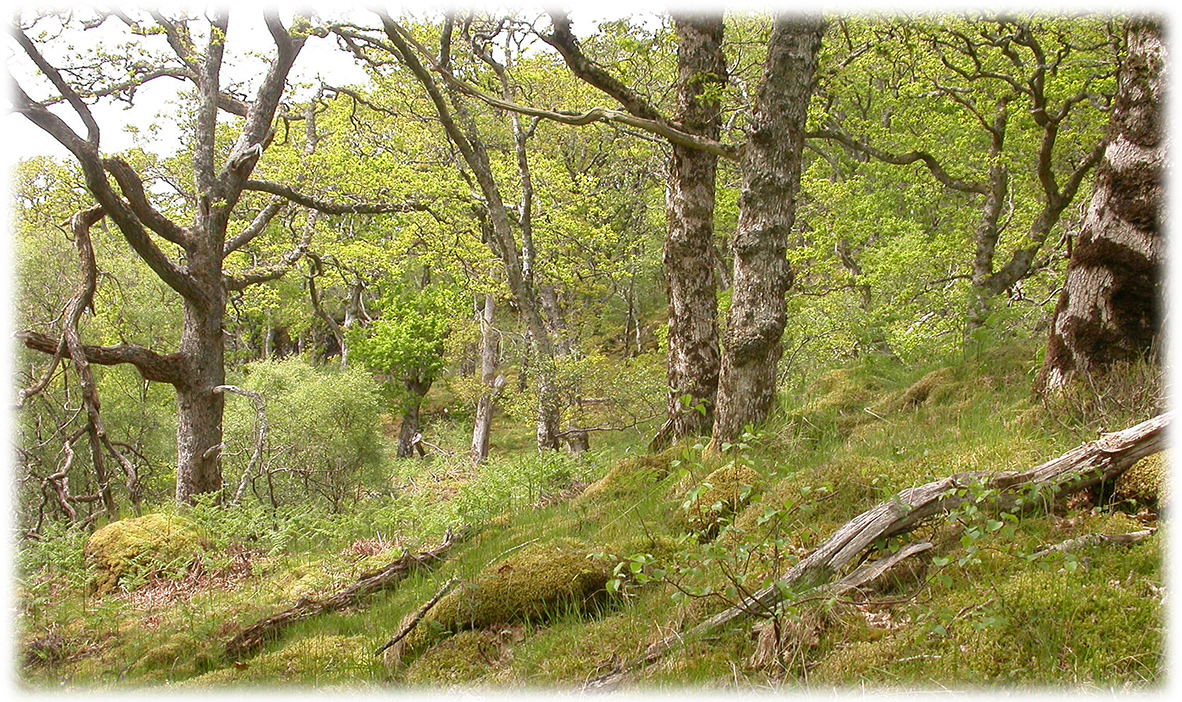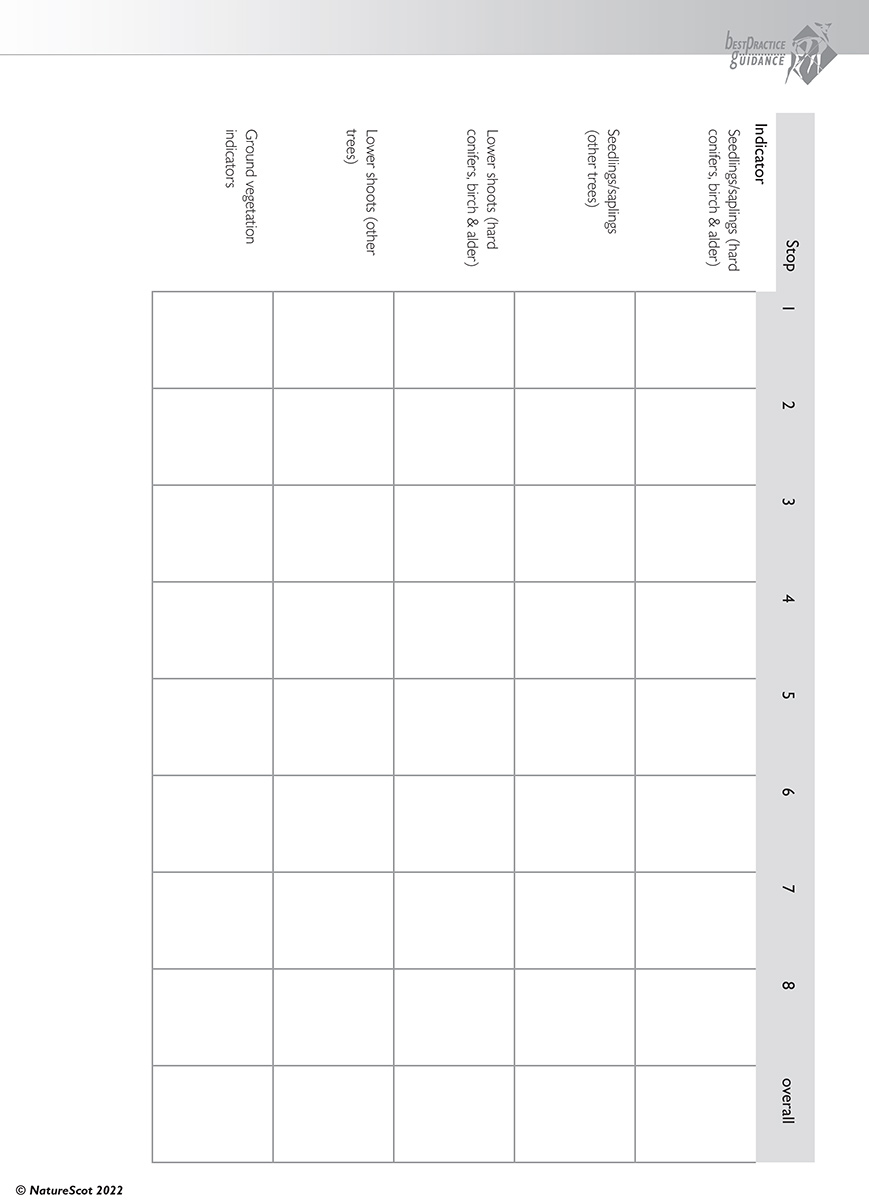
Undertake this survey BEFORE the start of the new growing season which, depending on location, will be sometime between February and May
Table 1: Number of ‘stops’ per woodland
<5Ha 2 ‘stops’ | 5-10Ha 3 ’stops’ | 10-30Ha 5 ‘stops’ | 30+Ha 8 ‘stops’
- Choose the woodland area to survey. Treat each deer fenced compartment as a separate woodland area.
For each area, decide how many stops you will do using Table 1. Allow around 45 minutes to complete each stop. - At each stop, mark your location with a stick or rucksack, and survey within a circle of radius ~25m (25 paces from the centre). Plan your stops with this in mind, and with the objective of covering the woodland evenly (ie. do not cluster all stops together over a small area). Avoid stopping near vehicle tracks or on difficult terrain (eg. scree or ravines)
- Record the Stop number, Date, Surveyor and (optional) Grid reference on the Field Sheet for each stop. The survey is to record all large herbivore browsing and grazing, whether domestic stock goats, pigs, hares, rabbits or deer.
Look for evidence of browsing (feeding on woody shoots) on 3 different ‘indicators’:
1. Seedlings (>5cm tall) and saplings (young trees less than 2m tall)
2. Lower shoots (includes basal shoots) of trees greater than 2m tall
3. Ground vegetation indicators: Blaeberry, Bramble, Bog myrtle, Hard fern & Raspberry
Because large herbivores prefer to feed on certain trees over others, we consider impacts on ‘unpalatable’ trees and ‘palatable’ trees separately. The unpalatable trees are ‘hard’ conifers* (i.e. old needles are stiff and spikey), Birch and Alder; while ‘other trees’ are palatable (e.g. Oak, Hazel, Holly, Rowan, Aspen, Willow and ‘soft’ conifers* (those with softer, less spikey and more pliable older needles). To complete this survey, you will need to be able to tell Alder and Birch apart from other deciduous trees.
We estimate levels of browsing based on how much growth from the preceding year has been eaten. This can be hard to tell at first, so it is good to get some practice – a photographic field guide is in preparation to help you. Only consider browsing on shoots that are readily accessible to large herbivores. Record N/A if an indicator is inaccessible.
Three levels are used:
1. >75% of last full year’s growth removed (Seedlings/saplings & Lower shoots); or
>75% of shoots browsed (Ground vegetation) [browsing easy to find and looks severe]
2. 25-75% of last full year’s growth removed (Seedlings/saplings & Lower shoots); or
25-75% of shoots browsed (Ground vegetation) [browsing easy to find and looks significant]
3. <25% of last full year’s growth removed (Seedlings/saplings & Lower shoots); or
<25% of shoots browsed (Ground vegetation) [browsing hard to find and looks insignificant]
For each indicator and palatability class, circle the option on the Field Sheet that best reflects the level of browsing present at the stop. It may help to keep a note of the impacts on each indicator that you find. If there is variability in browsing levels within an indicator/palatability class, the option you circle should represent the browsing rate that best represents the group as a whole. If, for example there are 4 trees that are 75-90% and 6 that are 25-75% browsed, the best summary is likely to be 25-75% browsed. If an indicator is absent at a stop, you can include examples of it found outside the stop area on the way to the next stop. - Once you have completed all your stops, summarise results in the Summary Table. Sometimes not all indicators give the same result, an overall impact level that best represents the range of impacts for each. Enter N/A where the indicator is not present. We recommend retaining all Field Sheets and the Summary Table for future reference.
Resurveying each year can help track how herbivore impacts are changing over time and allow management to be tailored to achieve a desired level of herbivore impact. The desired level of herbivore impact will depend upon the management objectives for the woodland. Table 2 provides a summary of the effect of each of the impact levels, if maintained over the long term, on the condition of established woodlands. This information may help with setting a target impact level for the woodland
Table 2: Implications of current herbivore impact level on established woodland if maintained over the long term
High or Very High
There will be very little, if any, successful regeneration of palatable tree and shrub species, either from seed or from shoots, and little regeneration of unpalatable tree and shrub species.
The ground flora will be of low species diversity with few or no preferentially grazed plant species present. There will be no or very little flowering and seed setting. The woodland will be open with a short ground layer, a very sparse, if any, shrub layer, no climbing plant species and a short field /ground layer dominated by a few plant species. Food and habitat for invertebrates, birds and small mammals will be limited.
The woodland, if it persists at all in the long term, will lose its palatable tree and shrub component.
There will be large volumes of deadwood as the woodland senesces
Medium
There will be little successful regeneration of palatable tree and shrub species.
Unpalatable tree and shrub species will be regenerating well, given suitable light conditions.
The ground flora will be of moderate species diversity with some preferentially grazed species present but in low abundance and producing very few, if any, flowers or seeds.
There may be abundant flowering and seed setting of plant species that are not preferentially grazed. There will be few, if any, climbing plants. Food and habitat for invertebrates, birds and small mammals will be favourable for those species able to use the moderately open and diverse woodland structure but limited range of tree, shrub and ground flora species. It will be unfavourable for species that require very open woodland or very abundant glades. In the long term the woodland will lose its palatable tree and shrub component
Low or No Impact
All species of tree and shrub with seed sources will be regenerating well given suitable light conditions although the abundance of young trees of more palatable species will be lower than if there were no browsing. The ground flora will be of high species diversity and all species will be able to flower and set seed to some degree. Climbing plants will be abundant. The diverse structure, frequently higher plant species diversity, and greater flowering and seeding, will provide food and habitat for many species of invertebrate, bird and mammal but may be unfavourable for those species that require open woodland and /or abundant glades. In the long term the woodland is likely to remain in a similar condition.


